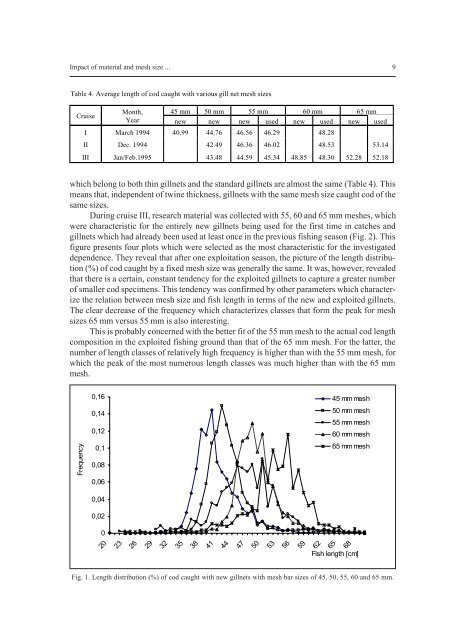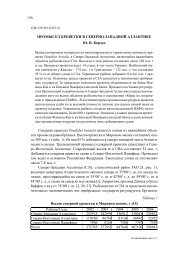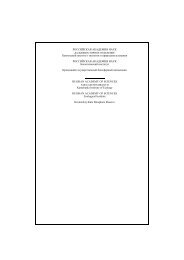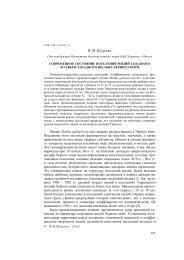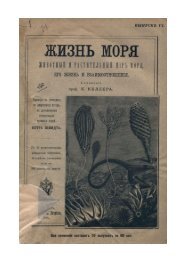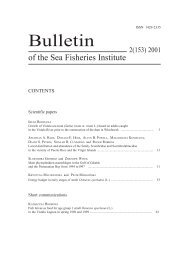Bulletin of the Sea Fisheries Institute 2 (156) 2002 - CEEMaR
Bulletin of the Sea Fisheries Institute 2 (156) 2002 - CEEMaR
Bulletin of the Sea Fisheries Institute 2 (156) 2002 - CEEMaR
Create successful ePaper yourself
Turn your PDF publications into a flip-book with our unique Google optimized e-Paper software.
Impact <strong>of</strong> material and mesh size ... 9<br />
Table 4. Average length <strong>of</strong> cod caught with various gill net mesh sizes<br />
Cruise<br />
Month, 45 mm 50 mm 55 mm 60 mm 65 mm<br />
Year new new new used new used new used<br />
I March 1994 40.99 44.76 46.56 46.29 48.28<br />
II Dec. 1994 42.49 46.36 46.02 48.53 53.14<br />
III Jan/Feb.1995 43.48 44.59 45.34 48.85 48.30 52.28 52.18<br />
which belong to both thin gillnets and <strong>the</strong> standard gillnets are almost <strong>the</strong> same (Table 4). This<br />
means that, independent <strong>of</strong> twine thickness, gillnets with <strong>the</strong> same mesh size caught cod <strong>of</strong> <strong>the</strong><br />
same sizes.<br />
During cruise III, research material was collected with 55, 60 and 65 mm meshes, which<br />
were characteristic for <strong>the</strong> entirely new gillnets being used for <strong>the</strong> first time in catches and<br />
gillnets which had already been used at least once in <strong>the</strong> previous fishing season (Fig. 2). This<br />
figure presents four plots which were selected as <strong>the</strong> most characteristic for <strong>the</strong> investigated<br />
dependence. They reveal that after one exploitation season, <strong>the</strong> picture <strong>of</strong> <strong>the</strong> length distribution<br />
(%) <strong>of</strong> cod caught by a fixed mesh size was generally <strong>the</strong> same. It was, however, revealed<br />
that <strong>the</strong>re is a certain, constant tendency for <strong>the</strong> exploited gillnets to capture a greater number<br />
<strong>of</strong> smaller cod specimens. This tendency was confirmed by o<strong>the</strong>r parameters which characterize<br />
<strong>the</strong> relation between mesh size and fish length in terms <strong>of</strong> <strong>the</strong> new and exploited gillnets.<br />
The clear decrease <strong>of</strong> <strong>the</strong> frequency which characterizes classes that form <strong>the</strong> peak for mesh<br />
sizes 65 mm versus 55 mm is also interesting.<br />
This is probably concerned with <strong>the</strong> better fit <strong>of</strong> <strong>the</strong> 55 mm mesh to <strong>the</strong> actual cod length<br />
composition in <strong>the</strong> exploited fishing ground than that <strong>of</strong> <strong>the</strong> 65 mm mesh. For <strong>the</strong> latter, <strong>the</strong><br />
number <strong>of</strong> length classes <strong>of</strong> relatively high frequency is higher than with <strong>the</strong> 55 mm mesh, for<br />
which <strong>the</strong> peak <strong>of</strong> <strong>the</strong> most numerous length classes was much higher than with <strong>the</strong> 65 mm<br />
mesh.<br />
Frequency<br />
0,16<br />
0,14<br />
0,12<br />
0,1<br />
0,08<br />
0,06<br />
0,04<br />
0,02<br />
0<br />
45 mm mesh<br />
50 mm mesh<br />
55 mm mesh<br />
60 mm mesh<br />
65 mm mesh<br />
20<br />
23<br />
26<br />
29<br />
32<br />
35<br />
38<br />
41<br />
44<br />
47<br />
50<br />
53<br />
56<br />
59<br />
62<br />
65<br />
68<br />
Fish length [cm]<br />
Fig. 1. Length distribution (%) <strong>of</strong> cod caught with new gillnets with mesh bar sizes <strong>of</strong> 45, 50, 55, 60 and 65 mm.


